🛑 Stop Guessing & Take Action Today!—Limited seats to ensure personalised attention! 👉 Learn More.
What Is Research and Why Is It Important For Content Writing?
Learn what research is all about, its importance in writing for accuracy and unique angles, and the types of research.
By Moses Attamah
7/23/20255 min read
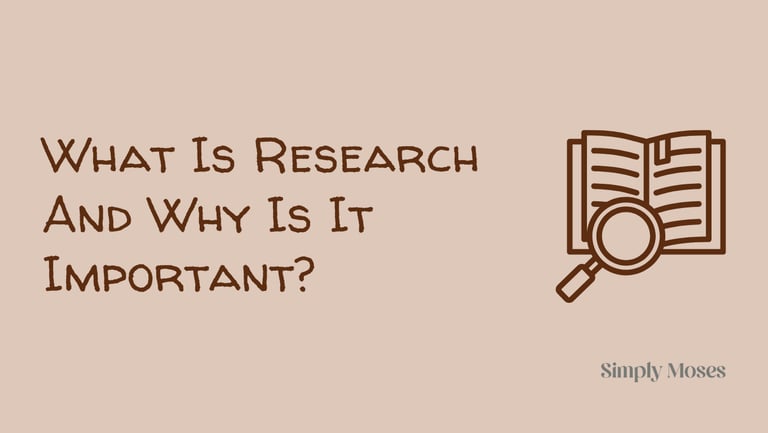

Writing isn’t just about creating engaging words.
It’s also about giving value through well-researched information.
In this article, you’ll know what research is, its importance in writing, and the types of research.
What is research?
Research is the systematic study of data and sources to establish facts, reach conclusions, and solve problems.
Data includes facts and figures collected during research for reference or analysis.
Research involves:
Gathering information: Collecting data from various sources
Analysing data: Examining and interpreting the collected information
Drawing conclusions: Reaching informed decisions or insights based on the analysis.
So, in simple words, research is all about gathering new data, analysing it, and making informed choices based on it.
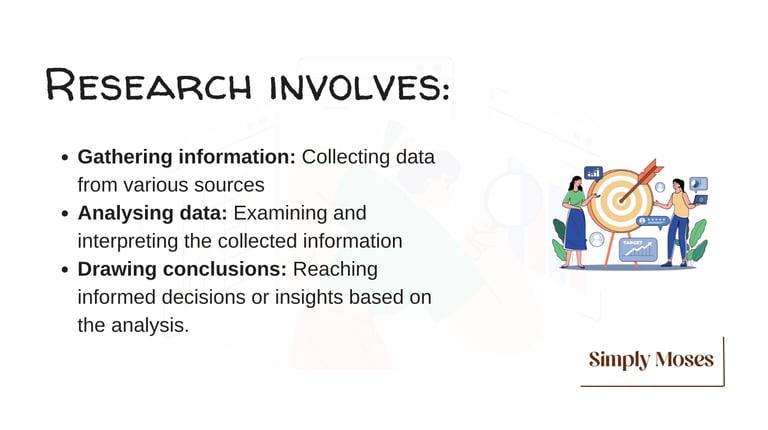

Why is research important?
Research is essential in every field, including science, the social sciences, the humanities, and business.
It is used to:
Discover and understand new facts and insights.
Solve problems and address challenges.
Provide evidence-based information for informed decision-making.
Why do we do research?
We conduct research for the following reasons:
1. To ensure accuracy and credibility
With so much information online, it’s challenging to determine what is accurate.
A 2024 UNESCO survey revealed that 62% of content creators don’t verify the information they share with their audiences.
This means their content might be false and misleading.
As a writer, following this path can damage trust and ultimately hurt your reputation.
So, research helps you verify facts, statistics, and claims to ensure they’re reliable and trustworthy.
And sharing accurate and credible information helps you build and maintain trust with your audience.
2. To uncover unique angles
Information has saturated the digital space.
And with AI, it’s easy to create generic words and ideas.
To stand out, you must offer a fresh perspective or address your topic in a new way.
This is where research comes in.
Research enables you to:
Examine existing content on a given topic.
Identify gaps in information.
Uncover new angles of the topic that haven't been thoroughly addressed.
This helps you break through the noise and capture your audience’s attention.
3. To support your points with evidence
Strong writing isn't just about stating opinions.
It’s also about presenting logical arguments backed by credible evidence.
Through research, you find the necessary data, statistics, expert opinions, case studies, and real-world examples to prove and strengthen your points.
Using your research findings helps you drive your points home and convince your audience.
See our practical guide on how to conduct research for writing articles and blog posts.
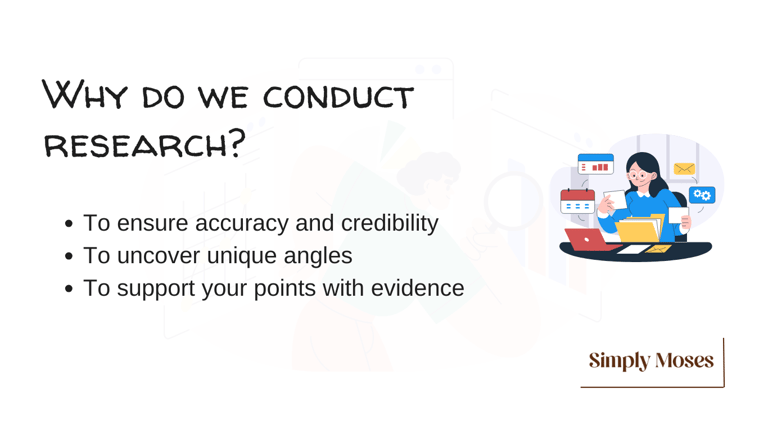

Subscribe to my newsletter!
Types of research
Research can be categorised into 2 broad types:
Qualitative
Quantitative.
Note that there are subcategories of research under these main types.
Meanwhile, let’s discuss the focus, aims, methods, and examples of the 2 major research types.
I. Qualitative research
Qualitative research focuses on collecting and analysing descriptive, non-numerical data to gain insights into people's experiences, perceptions, and behaviours.
Descriptive data includes observations, interpretations, and subjective experiences.
It's often expressed in words, stories, and rich descriptions.
The aims of this research type are to:
Understand underlying reasons, opinions, and motivations
Provide insights into a problem
Help to develop ideas or hypotheses for further quantitative research.
Methods of qualitative research and examples
1. In-depth interviews
This involves one-on-one conversations to examine the thoughts, feelings, and experiences of participants.
Example:
Having in-depth conversations with people to understand how they cope with stress or make career decisions
Read our guide on how to conduct interviews.
2. Focus groups
This involves group discussions led by a moderator to gather various perspectives from participants.
Example:
Testing people’s reactions to a new product and trying to understand why they like or dislike it
Read more about focus groups.
3. Content analysis
This means studying texts, images, or videos to identify patterns or themes.
Example:
Analysing social media trends to understand how people use social media to express opinions or share experiences
4. Case studies
This is an in-depth examination of a single case or a small number of cases.
Example:
Analysing how a business handled a crisis or implemented a new strategy
Read more about case studies.
5. Ethnography
This means immersing yourself in a culture or community to understand behaviours and norms.
Example:
Studying workplace culture to analyse how employees interact with and feel about their work environment
Qualitative research is helpful for digging into new topics, coming up with ideas, and understanding what people go through.

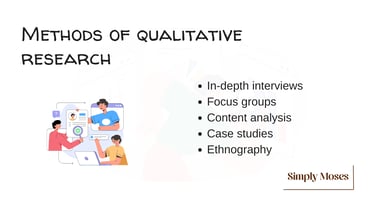

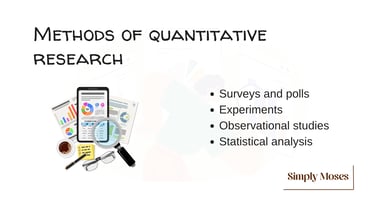
II. Quantitative research
Quantitative research focuses on collecting and analysing numerical data to understand facts, identify patterns, and test ideas.
The aims are to:
Quantify attitudes, opinions, or behaviours
Generalise results from a larger sample population.
Methods of quantitative research and examples
1. Surveys
This is collecting data through questionnaires or polls to measure attitudes, behaviours, or opinions.
Example:
A survey asking students to rate their satisfaction with online learning on a scale of 1 to 5
Read more about surveys and polls.
2. Experiments
This is a controlled study to test cause-and-effect relationships.
Example:
Testing and comparing the engagement performance of content published in the morning versus content published in the evening
Learn more about experiments.
3. Observational studies
This is collecting data by observing behaviour in a natural or controlled setting.
Example:
Studying how people use a website or app
See how to use observations in your research.
4. Statistical analysis
This means analysing existing data to identify trends or connections.
Example:
Analysing sales data to predict the direction of future performance
Quantitative research is ideal for testing ideas, spotting trends, and making informed decisions based on solid data.
Bottom line
Writing requires well-researched and data-driven information to provide value.
Research is crucial for finding data to establish facts and solve problems.
It ensures accuracy, uncovers unique perspectives, and supports arguments with evidence.
P.S. See our practical guide on how to conduct research for writing articles and blog posts.
Need personal mentorship?
I would love to hear from you
I hope you enjoyed reading this article.
What new thing did you learn from it? And was it helpful?
Did I miss anything?
Have any questions for me?
talk with me or send me your questions and concerns here:
simplymoses25[at]gmail[dot]com (simplymoses25@gmail.com).
Be assured I’ll respond to you within 12 hours.
